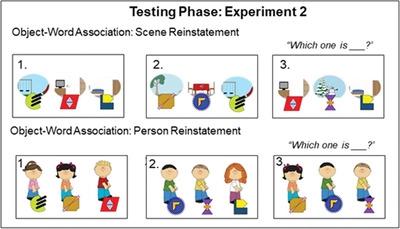Our official English website, www.x-mol.net, welcomes your feedback! (Note: you will need to create a separate account there.)
Not all is forgotten: Children's associative matrices for features of a word learning episode
Developmental Science ( IF 4.939 ) Pub Date : 2022-05-27 , DOI: 10.1111/desc.13291 Melina L Knabe 1 , Haley A Vlach 1
Developmental Science ( IF 4.939 ) Pub Date : 2022-05-27 , DOI: 10.1111/desc.13291 Melina L Knabe 1 , Haley A Vlach 1
Affiliation

|
Word learning studies traditionally examine the narrow link between words and objects, indifferent to the rich contextual information surrounding objects. This research examined whether children attend to this contextual information and construct an associative matrix of the words, objects, people, and environmental context during word learning. In Experiment 1, preschool-aged children (age: 3;2–5;11 years) were presented with novel words and objects in an animated storybook. Results revealed that children constructed associations beyond words and objects. Specifically, children attended to and had the strongest associations for features of the environmental context but failed to learn word-object associations. Experiment 2 demonstrated that children (age: 3;0–5;8 years) leveraged strong associations for the person and environmental context to support word-object mapping. This work demonstrates that children are especially sensitive to the word learning context and use associative matrices to support word mapping. Indeed, this research suggests associative matrices of the environment may be foundational for children's vocabulary development.
中文翻译:

并非所有人都被遗忘:儿童单词学习情节特征的联想矩阵
单词学习研究传统上检查单词和对象之间的狭窄联系,对对象周围丰富的上下文信息漠不关心。这项研究检查了儿童在单词学习过程中是否注意这些上下文信息并构建单词、对象、人和环境上下文的关联矩阵。在实验 1 中,学龄前儿童(年龄:3;2-5;11 岁)在动画故事书中看到了新奇的单词和物体。结果表明,儿童建立了超越文字和物体的联想。具体来说,儿童关注环境背景的特征并与之建立最强烈的关联,但未能学习词-物关联。实验 2 表明儿童(年龄:3;0-5;8 年)利用人与环境背景的强烈关联来支持词对象映射。这项工作表明儿童对单词学习上下文特别敏感,并使用关联矩阵来支持单词映射。事实上,这项研究表明环境的关联矩阵可能是儿童词汇发展的基础。
更新日期:2022-05-27
中文翻译:

并非所有人都被遗忘:儿童单词学习情节特征的联想矩阵
单词学习研究传统上检查单词和对象之间的狭窄联系,对对象周围丰富的上下文信息漠不关心。这项研究检查了儿童在单词学习过程中是否注意这些上下文信息并构建单词、对象、人和环境上下文的关联矩阵。在实验 1 中,学龄前儿童(年龄:3;2-5;11 岁)在动画故事书中看到了新奇的单词和物体。结果表明,儿童建立了超越文字和物体的联想。具体来说,儿童关注环境背景的特征并与之建立最强烈的关联,但未能学习词-物关联。实验 2 表明儿童(年龄:3;0-5;8 年)利用人与环境背景的强烈关联来支持词对象映射。这项工作表明儿童对单词学习上下文特别敏感,并使用关联矩阵来支持单词映射。事实上,这项研究表明环境的关联矩阵可能是儿童词汇发展的基础。



























 京公网安备 11010802027423号
京公网安备 11010802027423号